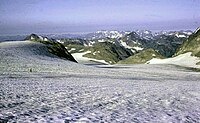
Photo from wikipedia
Abstract Glacier recession in response to climate warming has resulted in an increase in the size and number of glacial lakes. Glacial lakes are an important focus for research as… Click to show full abstract
Abstract Glacier recession in response to climate warming has resulted in an increase in the size and number of glacial lakes. Glacial lakes are an important focus for research as they impact water resources, glacier mass balance, and some produce catastrophic glacial lake outburst floods (GLOFs). Glaciers in Peru have retreated and thinned in recent decades, prompting the need for monitoring of ice- and water-bodies across the cordilleras. These monitoring efforts have been greatly facilitated by the availability of satellite imagery. However, knowledge gaps remain, particularly in relation to the formation, temporal evolution, and catastrophic drainage of glacial lakes. In this paper we address this gap by producing the most current and detailed glacial lake inventory in Peru and provide a set of reproducible methods that can be applied consistently for different time periods, and for other mountainous regions. The new lake inventory presented includes a total of 4557 glacial lakes covering a total area of 328.85 km2. In addition to detailing lake distribution and extent, the inventory includes other metrics, such as dam type and volume, which are important for GLOF hazard assessments. Analysis of these metrics showed that the majority of glacial lakes are detached from current glaciers (97%) and are classified as either embedded (i.e. bedrock dammed; ~64% of all lakes) or (moraine) dammed (~28% of all lakes) lakes. We also found that lake size varies with dam type; with dammed lakes tending to have larger areas than embedded lakes. The inventory presented provides an unparalleled view of the current state of glacial lakes in Peru and represents an important first step towards (1) improved understanding of glacial lakes and their topographic and morphological characteristics and (2) assessing risk associated with GLOFs.
Journal Title: Global and Planetary Change
Year Published: 2021
Link to full text (if available)
Share on Social Media: Sign Up to like & get
recommendations!